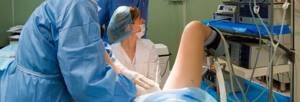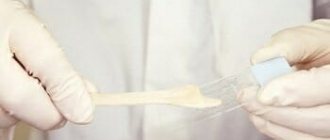- How is diagnostic curettage of the uterus performed?
- Recovery after surgery
- Possible complications after curettage of the uterine cavity:
- Advantages of the gynecology department based on the MCHC
Curettage of the uterus is a common procedure in gynecology. It is a minor surgical intervention and involves the removal of the superficial (functional) layer of the mucous membrane of the uterus and cervical canal. It is prescribed for diagnostic or treatment purposes.
Diagnostic curettage is performed to make or clarify the diagnosis. It involves taking samples for histological examination, allows you to assess the condition of the endometrium, the nature of neoplasms, and identify the causes of diseases. It is also considered therapeutic, since during curettage, neoplasms or pathologically altered epithelium in the uterine cavity are simultaneously removed. Both types of operations are performed using a special instrument - a curette.
Prices for curettage of the uterine cavity at the MCHC
The price for diagnostic uterine curettage in our clinic starts from 10,000 rubles. This cost includes the procedure itself.
| Initial appointment. OBSTETRIC-GYNECOLOGIST | 2000 |
| Ultrasound of the pelvic organs (transvaginal) | 1800 |
| Hospital complex of tests | 1500 |
| General clinical blood test + ESR | 350 |
| Coagulogram, screening | 1200 |
| Biochemical blood test, basic | 1200 |
| General urine analysis | 350 |
| Cytological examination of scrapings from the cervical canal | 500 |
| Cytological examination of scrapings from the cervix | 500 |
| Collection of material for research (smear) | 300 |
| Taking blood from a vein | 300 |
| Microscopic examination of the separated cervical canal | 200 |
| Microscopic examination of vaginal discharge | 200 |
| ECG at rest | 1200 |
| Consultation with a general practitioner based on research results | 1500 |
| Initial appointment. ANESTHESIOLOGIST-RESENIMATOLOGIST | 1200 |
| Intravenous anesthesia | from 8100 |
| Histological examination of biopsy material (endoscopic material, scrapings of the uterine cavity, scrapings of the cervical canal) | 3500 |
| RDV + hysteroscopy | 14400 |
Doctor's comment
Have you been prescribed a diagnostic curettage and are you waiting with the doom of a victim for the appointed date? Of course, the name of the procedure sounds intimidating, and, using their imagination, some patients refuse the examination. By the way, it is completely in vain, because performing this procedure is no more painful and traumatic than many other manipulations. During the procedure, the doctor removes only the superficial layer in the uterine cavity, which is periodically removed during menstruation. The inner layer, located deeper, is not affected by scraping. A professionally performed manipulation cannot harm a woman’s health. In addition, this is one of the effective diagnostic methods, which makes it possible to detect with high accuracy both the source of the pathology and the cause of the disorders that have arisen. In some cases, curettage is the only way to treat or diagnose. If the cause for concern is fear of possible painful sensations, then you need to know that the procedure is performed under anesthesia. In our clinic, curettage is performed using the most modern equipment. Would you like more information about your upcoming examination? Make an appointment and together we will discuss all the problems that concern you.
Head of the surgical service at SwissClinic Konstantin Viktorovich Puchkov
Separate diagnostic curettage (RDC)
Separate diagnostic curettage consists of two stages. This type of manipulation involves the sequential removal of the mucosal epithelium from the cervix, and then from the organ cavity. The endometrium and the mucous membrane of the cervix have different structures, but pathologies can develop in both parts of the organ, and they can be of a different nature. That is why the removed biological material is taken and examined separately. This allows histological analysis to accurately assess changes and clarify pathologies in each part of the organ.
The information content of the procedure increases when performing RDV using a hysteroscope, an endoscopic device with a video system and a light source. It allows you to make a visual assessment, examine the uterine cavity in detail, and identify pathological formations. Separate diagnostic curettage of the cervical canal and uterine cavity under hysteroscopy control ensures control of the effectiveness of endometrial removal, accuracy of the procedure and reduces the likelihood of negative consequences of surgical intervention. The use of a hysteroscope is mandatory during intervention if the uterus has an abnormal location or there is a risk of its perforation (violation of integrity).

Structure of the uterus
The uterus is a hollow smooth muscle organ with thick walls. At the top, on both sides, it is connected to the fallopian tubes, at the bottom - through the cervical canal to the vagina. Its shape resembles a pear, located in the center of the pelvic cavity; Normally, its length is 7-10 cm. It is in the uterus that the fetus develops and it is the uterus, contracting, that pushes it out through the vagina during childbirth.
The uterus consists of a body, cavity, cervix and pharynx. The mucous cavity inside is lined with columnar epithelium, and the neck is lined with prismatic and stratified squamous epithelium. These functional tissues are modified during the cycle and are rejected at the end of the cycle. It is they who are completely scraped out during RDV (together with the epithelium of the cervical canal). And from the 1st day of the new cycle, the mucous layer of the endometrium begins to grow again.
Symptoms for which the procedure is performed:
- uncharacteristic discharge, leucorrhoea;
- menstruation disorders, uterine bleeding in postmenopause;
- pain in the pelvic area;
- infertility;
- miscarriages.
Hysteroscopy with curettage of the uterine cavity allows you to identify and eliminate:
- polyps;
- submucosal nodes of leiomyoma;
- intrauterine synechiae and septa.
In addition, with its help:
- expand the cervical canal;
- the overgrown endometrium is scraped or excised;
- they do endometrial scratching (a special “scratch” before IVF to increase the chances of embryo consolidation);
- They do a targeted biopsy of the endometrium (tissue collection from the area of interest for analysis).
Indications for diagnostic curettage
- Uterine bleeding outside of menstruation or after menopause.
- Menstrual dysfunction, cycle disruptions.
- Polyp of the body of the uterus, polyp of the cervix.
- Suspicion of an inflammatory process in the uterine mucosa or endometrium.
- Dysplasia (precancerous changes in the cervix).
- Endometriosis.
- Endometrial hyperplasia.
- Suspicion of cervical cancer, uterine cancer.
- Adhesive process in the uterine cavity.
- Suspicion of the presence of remnants of the fetal egg during incomplete abortion, fragments of placental tissue, the formation of placental polyps after childbirth.

Contraindications and possible complications during the procedure
Absolute contraindications are acute infectious diseases and inflammatory processes of the genital organs.
With a careful and correct approach by a specialist to this manipulation, complications can be avoided. However, you need to be aware of the possible complications of curettage:
- perforation of the uterus.
- cervical rupture.
- inflammation of the uterus. Occurs when microbes enter the uterus. Currently, to prevent infection of the uterus after curettage, doctors prescribe a course of antibiotic treatment.
- accumulation of blood in the uterine cavity (hematometra). If, after curettage, a spasm of the cervix occurs, blood, which normally should flow from the uterine cavity for several days, accumulates in it and can become infected and cause pain.
- damage to the mucous membrane (excessive curettage) - if you scrape very hard and aggressively, you can damage the germinal layer of the mucous membrane, which will lead to the fact that the new mucous membrane will no longer grow.
Preparation for the procedure
Diagnostic curettage of the uterine cavity is prescribed only after a preliminary examination. Before carrying out it is necessary to undergo research :
- examination on a gynecological chair;
- blood tests - general, biochemical, clinical, blood group and Rh factor, hepatitis B and C, HIV, syphilis, hormones, coagulogram and other tests determined by the attending physician;
- smear analysis - microflora, cytology;
- general urine analysis;
- ECG (electrocardiogram);
- fluorography.
You also need to consult a therapist to rule out contraindications to surgery under anesthesia based on the results of previous examinations.
Curettage of the uterus is carried out with 1–2 degrees of vaginal cleanliness. If the degree is low, its sanitation and the use of drugs with an active antimicrobial effect are required. An exception is if the procedure is prescribed after childbirth if there is a suspicion of the presence of placenta particles in the uterus.
When prescribing surgical intervention, it is necessary to inform the gynecologist about all medications that you are constantly taking.
If you have chronic diseases, you may need to consult a specialist to receive specific recommendations on treatment tactics during the procedure itself and in the postoperative period.
To avoid complications during uterine curettage and speed up recovery, physical training :
- a few weeks in advance it may be necessary to stop taking medications that affect blood clotting (the patient does not make this decision independently);
- for several days you cannot use vaginal suppositories or douche;
- 5–7 days in advance you should abstain from sexual intercourse;
- You must abstain from eating food 12 hours in advance and from liquids on the day of surgery;
- Before the procedure, you need to sanitize the genital organs.
Diagnostic curettage is usually prescribed after the end of menstruation. If endometrial inflammation is suspected, intervention is carried out in the first phase, that is, on days 5–7 of the cycle; in case of uterine bleeding, it is performed immediately.

How is diagnostic curettage of the uterus performed?
Diagnostic curettage is a rather painful procedure, since it involves surgical intervention, so it is performed under general or local anesthesia on a gynecological chair. Before the operation, the perineal and vaginal area is treated with an antiseptic solution.
The procedure consists of stages.
- Exposing the cervix using a gynecological speculum, fixing it with bullet forceps.
- Gradual opening of the cervical canal using special dilators of different diameters - from small to large.
- Insertion of a hysteroscope into the expanded canal for visual assessment and control of complete removal of pathological formations (if the procedure is carried out under hysteroscopy control).
- Collection of material from the uterine cavity using curettes of different sizes. If RDV of the uterus is performed, the epithelium is removed first from the cervix and then from the cavity.
- Removal of instruments, postoperative treatment of the vagina and cervix.
The average duration of the operation is 20 minutes. Upon completion, the woman is transferred to a hospital ward. The biomaterial obtained during diagnostic curettage is placed in a sterile container with a chemical solution and sent for further histological examination.

Prices
Price (rub.)In installments* (rub.)Consultation with a surgeon on the operation (SPECIAL)0—Online doctor’s opinion on the operation (SPECIAL)0—Hysteroscopy + separate diagnostic curettage (RDV) I category of complexity 15000—Hysteroscopy + separate diagnostic curettage (RDV) II category of difficulty 25000—* You can read more about the conditions here - Treatment on credit or in installments
The cost is preliminary. The exact cost of the operation can only be determined by a surgeon during a free consultation.
Hysteroscopic examination, or hysteroscopy (hystero - uterus, copy - examination) is a diagnostic examination of the internal mucous layer of the cavity and cervix (endometrium) using a microvideo camera. It allows you to identify most tissue pathologies, including those causing infertility. In addition, under the control of hysteroscopy, separate diagnostic curettage of the RDV of the uterine cavity is performed. This is a minor surgical operation to collect endometrial cells for histological examination (separate because it is carried out in stages: first the cervix is scraped out, and then different parts of the uterus are scraped).
Also, during hysteroscopy, it is possible to perform therapeutic manipulations, including therapeutic and diagnostic curettage of the LDV. If benign pathological neoplasms are excised during manipulation, the procedure is called hysteroresistoscopy.
Method capabilities:
- allows you to visually evaluate uterine tissue and make a diagnosis of their pathological changes;
- allows you to immediately eliminate polyps and cut adhesions;
- allows microsurgical interventions to be performed with maximum precision due to image magnification tens of times;
- low-traumatic and easily tolerated by patients;
- requires a hospital stay of only 1 day.
Shishkina Yulia Sergeevna
Obstetrician-gynecologist, gynecologist-endocrinologist, reproductive specialist, operating gynecologist
“Hysteroscopy can be prescribed to a patient not only for diagnostic, but also for therapeutic purposes. This procedure allows you to remove an ingrown IUD, dissect adhesions, eliminate the consequences of an unsuccessful abortion, remove polyps and much more. Today this is one of the most modern and effective techniques.”
Hysteroscopy with RDV allows you to identify and eliminate most benign pathologies of the uterine mucosa at the earliest stages. According to estimates from practicing gynecological surgeons, the accuracy, information content and safety of the procedure reaches 95%. Source: Diagnosis of pathology of the uterine cavity in patients suffering from tubo-peritoneal infertility / Korsak BC [et al.] // Journal of Obstetrics and Women's Diseases. - 2005. - issue 3. — P.50–53. Korneeva I. E. State of the concept of diagnosis and treatment of infertility in marriage: abstract of thesis. dis. ...Dr. med. Sci. - M., 2003.
SM-Clinic specialists perform all types of hysteroscopy of levels 1 and 2 of complexity:
- Level 1 – assumes the presence of polyps or synechiae (adhesions) of grade 1-2 according to the Asherman classifier.
- Level 2 – involves grade 3-4 synechiae, or septa/adhesions in the uterus, or stage 0 fibroids (the nodes do not grow deep into the organ).
The duration of the procedure is 1-2 hours, depending on the complexity of the manipulations. After the intervention, the patient remains in the hospital under medical supervision for about 3 hours.
Transcervical method
General anesthesia
Operation time - 1-2 hours
Recovery in a day hospital
Recovery after surgery
Diagnostic curettage of the uterus is considered a simple but serious operation. Rehabilitation lasts about two weeks. In the absence of complications, the woman remains in the hospital from several hours to two days. As a rule, patients return to normal life the next day.
Normal after the procedure are:
- severe pain in the lower abdomen in the first hours;
- uterine bleeding for several hours;
- spotting for 7–14 days;
- nagging pain in the lower abdomen for 2–5 days;
- drowsiness during the day as a consequence of anesthesia.
To prevent infectious complications, the doctor prescribes a course of antibiotics and anti-inflammatory drugs; in case of severe pain, an anesthetic may be indicated.
Recommendations for recovery during the rehabilitation period:
- do not lift heavy objects for 4 weeks, limit physical activity, avoid tiring work for 2 weeks;
- do not douche, do not use tampons;
- do not visit saunas and baths, do not take a bath for two weeks;
- abstain from sexual intercourse.
A week after the diagnostic curettage, the woman needs to visit a gynecologist for a follow-up examination. An ultrasound may be performed to evaluate the condition of the cavity and cervix. The doctor determines the need for further treatment based on the results of histological analysis.
After removing the endometrium during cleansing of the uterus, the mucous membrane is restored during the cycle. The first menstruation usually occurs after 4–6 weeks (the day of surgery should be considered the first day of the cycle). If the discharge is heavy or scanty, consult a doctor. Reproductive function with good regeneration is normalized after menstruation. However, the opportunity to get pregnant will appear after two or three full cycles.
Reviews
During a routine examination, a uterine polyp was discovered and a uterine cleaning was prescribed. Of course, I was very afraid of her, having read reviews on the Internet. I waited until the end of the cycle and went to see my gynecologist at the Lama clinic for surgery. Everything went very simply and quickly. I arrived at the clinic in the morning, half an hour later they sent me to the operating room, gave me anesthesia, and at 11 I already came to my senses in the ward. It didn’t hurt much afterwards, a little more than during menstruation. Two hours later my husband came for me and took me home. The polyp was submitted for histology. Thank God no cancer. The discharge ended after 7 days and the cycle was not very affected. I recommend everyone not to be afraid, but to do the cleaning calmly. It's not so scary when it's done by a professional surgeon. I recommend Zhanna Georgievna Muradova.
Vera (Moscow, 2012)
“If it weren’t for Zhanna Georgievna, I might never have become a mother. The fact is that at the local clinic, they could not answer my question: why I cannot get pregnant, prescribing various ultrasounds and other tests. But as it turned out, in order to identify the problem, it was enough to make a WFD. Zhanna Georgievna not only gave me hope, after the Russian Far East I successfully completed treatment, and now I am a happy mother. Now I recommend the clinic to all my friends, because I’m sure they will help.”
Galina (Mytishchi, 2015)
“For several years I was unsuccessfully treated for various female diseases, and the diagnosis was different all the time. I decided to go to the Lama clinic (I found information on the Internet, after a long search, and chose it). Here I was received by a wonderful doctor, Muradova Zhanna Georgievna, who, after examining me, prescribed separate diagnostic curettage (RDC). At first I was very scared of this procedure, but Zhanna Georgievna explained that the RDV would help make a clear diagnosis and assured me of safety. Thanks to such a professional approach, I not only learned my diagnosis, I received such long-awaited help. Thank you to all the good people of Lama - you are people who give hope and joy."
Natalya (Moscow, 2015)
She was treated for infertility at the Lama clinic by Muradova Zh.G. They did all the tests and found everything was fine. We tried artificial insemination, but still couldn’t get pregnant. We decided to do a diagnostic curettage of the uterus to improve the properties of the mucous membrane. This was done 2 days before the start of menstruation. The operation itself took half a day, in the morning I was cleaned under anesthesia, and then before lunch I came to my senses in the ward. It wasn’t very painful afterwards, it was unpleasant, but tolerable. The discharge was profuse, stronger than during menstruation, and lasted about three days. Then everything was like during menstruation. In total, the discharge lasted for 8 days. The procedure was successful. On the second cycle after cleansing, I managed to get pregnant. I'm expecting a baby soon. I recommend the Lama clinic. Very pleasant and professional approach.
Anna (Moscow, 2013)
I went to the Clinic on the recommendation of a friend (I have been seeing gynecologist Zh. G. Muradova for a long time). After consultation and passing all the necessary tests, an RDV was prescribed to remove the polyp. The operation was performed very efficiently, there were no complications or relapses. I am very grateful to Zhanna Georgievna personally and to the Clinic as a whole. The staff is polite and competent. When you are in the Clinic you feel at home.
Olga (Moscow, May 2013)
Articles on the topic
Endometrium RDV treatment methods
Hyperplastic processes in endometrial tissue are a very common pathology, and the incidence of diseases associated with such processes increases significantly in the perimenopausal period. Hyperplastic processes often become a favorable background for the development of cancer, which is why it is so important to contact […]
Hyperplasia RDV treatment methods
Endometrial hyperplasia - this term refers to such a pathology as an overgrown inner lining of the uterus. In gynecological practice, such pathology occurs quite often. Women with endometrial hyperplasia require a thorough examination followed by treatment, because endometrial hyperplasia is often an activator of oncological processes in […]
Possible complications after curettage of the uterine cavity:
- cervical spasm due to the formation of a large blood clot;
- development of the inflammatory process in the organs of the genitourinary system;
- formation of adhesive process;
- perforation of the uterus due to damage to the walls of the organ with a surgical instrument.
If you notice signs that may indicate a dangerous condition, consult a doctor immediately. These include the following:
- absence of bleeding after surgery or sudden cessation of discharge;
- severe pain in the lower abdomen that does not go away after taking painkillers;
- uterine bleeding lasting several days;
- fever, high temperature, nausea, weakness, fainting, dizziness;
- discharge with an unpleasant odor.
The causes of complications are most often non-compliance with recommendations during the recovery period and violation of the surgical technique.

! See a doctor immediately if...!
- you very quickly stopped bleeding from the vagina and began to experience abdominal pain;
- your temperature has risen above 38°C;
- you have severe abdominal pain that does not go away after taking painkillers;
- you experience heavy vaginal bleeding that quickly fills your sanitary pads and does not stop for several hours;
- you have copious, foul-smelling vaginal discharge;
- your health suddenly deteriorates, you feel dizzy, weak or lost consciousness.
Advantages of the gynecology department based on the MCHC
Specialists of the International Center for Health Protection perform diagnostic curettage in compliance with standards and rules. The gynecology department has a hospital with an operating unit.
Advantages of MCOH:
- highly qualified and extensive experience of doctors;
- professional and attentive approach to each patient;
- use of modern medical equipment;
- use of anesthetics and other drugs with a high safety profile;
- comfortable rooms for operations and rehabilitation.









